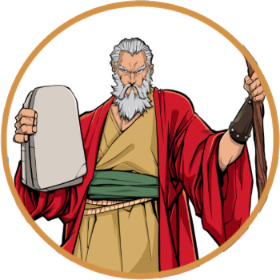(א) משֶׁה קִבֵּל תּוֹרָה מִסִּינַי, וּמְסָרָהּ לִיהוֹשֻׁעַ, וִיהוֹשֻׁעַ לִזְקֵנִים, וּזְקֵנִים לִנְבִיאִים, וּנְבִיאִים מְסָרוּהָ לְאַנְשֵׁי כְנֶסֶת הַגְּדוֹלָה. הֵם אָמְרוּ שְׁלשָׁה דְבָרִים, הֱווּ מְתוּנִים בַּדִּין, וְהַעֲמִידוּ תַלְמִידִים הַרְבֵּה, וַעֲשׂוּ סְיָג לַתּוֹרָה:
(1) Moshe received Torah from Sinai and transmitted it to Joshua, and Joshua to the Elders, and the Elders to the Prophets, and the Prophets transmitted it to the Men of the Great Assembly. They said three things: Be deliberate in judgment, raise up many disciples and make a fence for the Torah.
ואמר רבי לוי בר חמא אמר רבי שמעון בן לקיש מאי דכתיב ואתנה לך את לחת האבן והתורה והמצוה אשר כתבתי להורתם לחת אלו עשרת הדברות תורה זה מקרא והמצוה זו משנה אשר כתבתי אלו נביאים וכתובים להרתם זה תלמוד מלמד שכולם נתנו למשה מסיני:
And Rabbi Levi bar Ḥama said that Rabbi Shimon ben Lakish said: God said to Moses, “Ascend to me on the mountain and be there, and I will give you the stone tablets and the Torah and the mitzva that I have written that you may teach them” (Exodus 24:12), meaning that God revealed to Moses not only the Written Torah, but all of Torah, as it would be transmitted through the generations.
The “tablets” are the ten commandments that were written on the tablets of the Covenant,
the “Torah” is the five books of Moses.
The “mitzva” is the Mishna, which includes explanations for the mitzvot and how they are to be performed.
“That I have written” refers to the Prophets and Writings, written with divine inspiration.
“That you may teach them” refers to the Talmud, which explains the Mishna.
These explanations are the foundation for the rulings of practical halakha. This verse teaches that all aspects of Torah were given to Moses from Sinai.
The “tablets” are the ten commandments that were written on the tablets of the Covenant,
the “Torah” is the five books of Moses.
The “mitzva” is the Mishna, which includes explanations for the mitzvot and how they are to be performed.
“That I have written” refers to the Prophets and Writings, written with divine inspiration.
“That you may teach them” refers to the Talmud, which explains the Mishna.
These explanations are the foundation for the rulings of practical halakha. This verse teaches that all aspects of Torah were given to Moses from Sinai.
שְׁמַ֖ע יִשְׂרָאֵ֑ל יְהֹוָ֥ה אֱלֹהֵ֖ינוּ יְהֹוָ֥ה ׀ אֶחָֽד׃ וְאָ֣הַבְתָּ֔ אֵ֖ת יְהֹוָ֣ה אֱלֹהֶ֑יךָ בְּכׇל־לְבָבְךָ֥ וּבְכׇל־נַפְשְׁךָ֖ וּבְכׇל־מְאֹדֶֽךָ׃ וְהָי֞וּ הַדְּבָרִ֣ים הָאֵ֗לֶּה אֲשֶׁ֨ר אָנֹכִ֧י מְצַוְּךָ֛ הַיּ֖וֹם עַל־לְבָבֶֽךָ׃ וְשִׁנַּנְתָּ֣ם לְבָנֶ֔יךָ וְדִבַּרְתָּ֖ בָּ֑ם בְּשִׁבְתְּךָ֤ בְּבֵיתֶ֙ךָ֙ וּבְלֶכְתְּךָ֣ בַדֶּ֔רֶךְ וּֽבְשׇׁכְבְּךָ֖ וּבְקוּמֶֽךָ׃ וּקְשַׁרְתָּ֥ם לְא֖וֹת עַל־יָדֶ֑ךָ וְהָי֥וּ לְטֹטָפֹ֖ת בֵּ֥ין עֵינֶֽיךָ׃ וּכְתַבְתָּ֛ם עַל־מְזֻז֥וֹת בֵּיתֶ֖ךָ וּבִשְׁעָרֶֽיךָ׃ {ס}
Hear, O Israel! The LORD is our God, the LORD alone. You shall love the LORD your God with all your heart and with all your soul and with all your might. Take to heart these instructions with which I charge you this day. Impress them upon your children. Recite them when you stay at home and when you are away, when you lie down and when you get up. Bind them as a sign on your hand and let them serve as a symbol on your forehead; inscribe them on the doorposts of your house and on your gates.
וזה הוא תנור של עכנאי מאי עכנאי אמר רב יהודה אמר שמואל שהקיפו דברים כעכנא זו וטמאוהו תנא באותו היום השיב רבי אליעזר כל תשובות שבעולם ולא קיבלו הימנו
If a man made an oven out of separate coils [of clay, placing one upon another], then put sand between each of the coils — such an oven, R. Eliezer declared, is not susceptible to defilement, while the sages declared it susceptible. It is taught: On that day R. Eliezer brought forward every imaginable argument, but the Sages did not accept any of them. Finally he said to them: "If the Halakhah (religious law) is in accordance with me, let this carob tree prove it!" Sure enough the carob tree immediately uprooted itself and moved one hundred cubits, and some say 400 cubits, from its place. "No proof can be brought from a carob tree," they retorted. And again he said to them "If the Halakhah agrees with me, let the channel of water prove it!" Sure enough, the channel of water flowed backward. "No proof can be brought from a channel of water," they rejoined. Again he urged, "If the Halakhah agrees with me, let the walls of the house of study prove it!" Sure enough, the walls tilted as if to fall. But R. Joshua, rebuked the walls, saying, "When disciples of the wise are engaged in a halakhic dispute, what right have you to interfere?" Hence in deference to R. Joshua they did not fall and in deference to R. Eliezer they did not resume their upright position; they are still standing aslant. Again R. Eliezer then said to the Sages, "If the Halakhah agrees with me, let it be proved from heaven." Sure enough, a divine voice cried out, "Why do you dispute with R. Eliezer, with whom the Halakhah always agrees?" R. Joshua stood up and protested: "The Torah is not in heaven!" (Deut. 30:12). We pay no attention to a divine voice because long ago at Mount Sinai You wrote in your Torah at Mount Sinai, `After the majority must one incline'. (Ex. 23:2)" R. Nathan met [the prophet] Elijah and asked him, "What did the Holy One do at that moment?" Elijah: "He laughed [with joy], saying, 'My children have defeated Me, My children have defeated Me.'"




